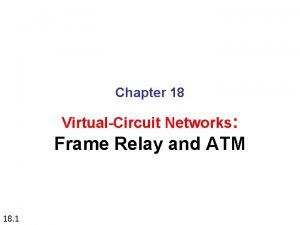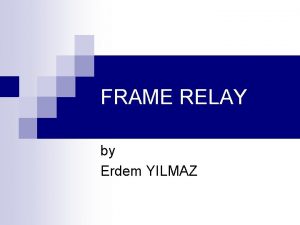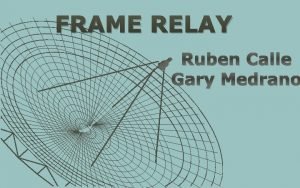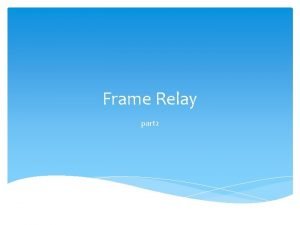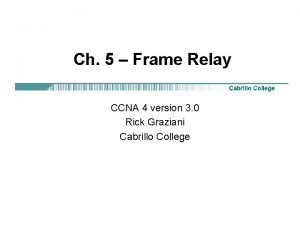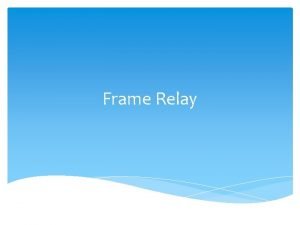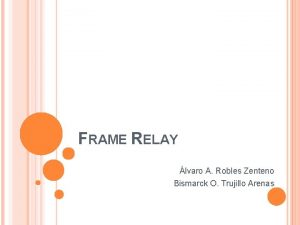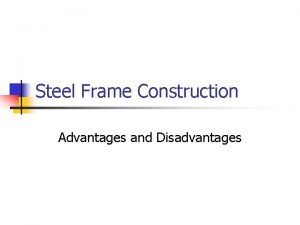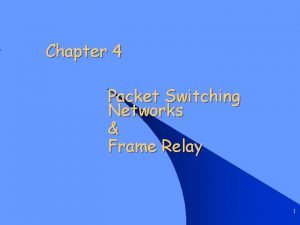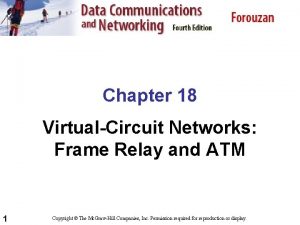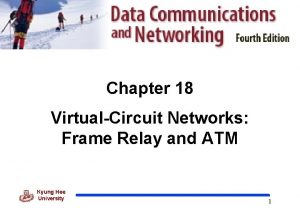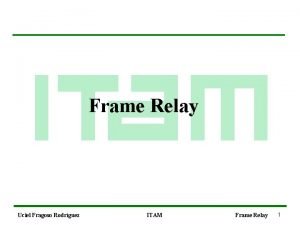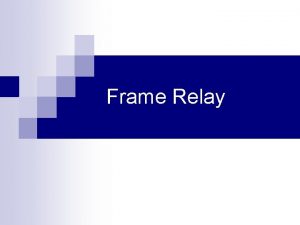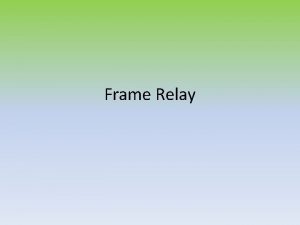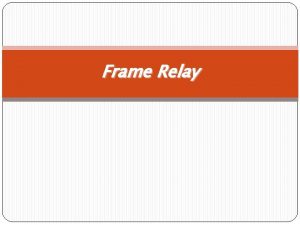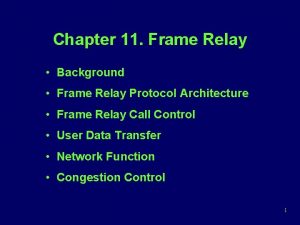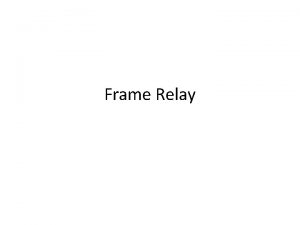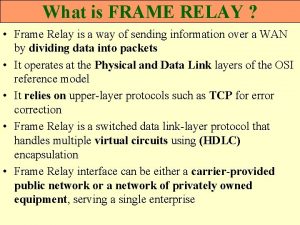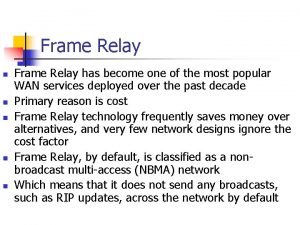Semester 4 Chapter 6 Frame Relay Frame Relay

















- Slides: 17

Semester 4 – Chapter 6 - Frame Relay • Frame Relay - Industry-standard, switched datalink layer protocol that handles multiple virtual circuits using HDLC encapsulation between connected devices. • Frame Relay is more efficient than X. 25, the protocol for which it is generally considered a replacement. • By using a simplified framing with no error correction mechanisms over high-quality digital facilities, Frame Relay can transmit data very rapidly, compared to other WAN protocols. • Frame Relay uses Layer 2 identifiers (DLCIs) and Permanent Virtual Circuits (PVCs).

Frame-Relay Technologies Frame Relay WAN technology provides a flexible method of connecting LANs over Frame Relay WAN links: – A ITU-T (CCITT) & American National Standards Institute (ANSI) standard – Defines the process for sending data over a Public Data Network (PDN) – Uses Virtual Circuits (VCs) to establish connections across the WAN – A connection-oriented service - the complete path to the destination is established prior to the sending of the first frame

Technologies Continued • • • DLCIs are used to identify Virtual Circuits Provides a means for multiplexing many logical data conversations (referred to as virtual circuits) by assigning each pair of DTEs connection identifiers Can divide a single Physical WAN Interface into multiple Subinterfaces Operates at the Physical and Data Link Layers of the OSI model but it relies on upper-layer protocols such as TCP for error correction A data-link technology that is streamlined (little error checking) to provide high performance and efficiency Defines the interconnection process between the Customer Premises Equipment (CPE) (also known as data terminal equipment - DTE), such as a router, and the service provider's local access switching equipment (known as data communications equipment - DCE)

Packet/Cell Switched Connections Frame Relay (key points): • Simpler and faster than X. 25 • PVC (Permanent Virtual Circuit) only, SVC (Switched Virtual Circuit) has been specified • Access is at 56 kbps, 64 kbps, or 1. 544 Mbps • Typically operates up to T 1 • Very streamlined (little error checking) • Has none of the reliability features/complexity of X. 25 • Uses: – – LAN-to-LAN connectivity Remote access Logical DTE (router) to logical DCE (Frame Relay switch) Virtual Circuits (VC) are end-to-end

VC (Virtual circuit) to ensure reliable communication between two network devices. Logical circuit created A virtual circuit is defined by a VPI/VCI (Virtual Path Identifier/Virtual Channel Identifier) pair Can be either permanent (a PVC) or switched (an SVC). Virtual circuits are used in Frame Relay and X. 25.

PVC (Permanent Virtual Circuit) Virtual circuit that is permanently established. PVCs save bandwidth associated with circuit establishment and tear down in situations where certain virtual circuits must exist all the time.

SVC (Switched Virtual Circuit) Virtual circuit that is: – dynamically established on demand – torn down when transmission is complete. SVCs are used in situations where data transmission is sporadic. It is not used in Frame Relay, but it has been specified.

FRAD (Frame Relay Access Device) Any network device that provides a connection between a LAN and a Frame Relay WAN. Frame Relay Service and Circuits: – Data-Link Connection Identifier (DLCI) – Committed information rate (CIR) – Access rate is 56 kbps, 64 kbps, or 1. 544 Mbps – One physical access interface – One logical hop to any point – Implemented mostly as a carrier-provided service – Can also be used for private networks

DLCI(Data-link Connection Identifier) A 'local identifier' between the DTE and the DCE, it identifies the logical connection that is multiplexed into the physical channel. Value that specifies a PVC in a Frame Relay network. In the basic Frame Relay specification, DLCIs are 'locally significant'. In the LMI extended specification, DLCIs are 'globally significant' (DLCIs specify individual end devices). The FR Switch maps the DLCIs between each pair of routers to create a PVC. DLCI values are typically assigned by the Frame Relay service provider

LMI(Local Management Interface) A signalling standard between the CPE device and the FR Switch that is responsible for managing the connection and maintaining "status" between the devices. Set of enhancements to the basic Frame Relay specification. LMI includes support for: • 'keepalive mechanism', which verifies that data is flowing; • 'multicast mechanism', which provides the network server with its local DLCI and the multicast DLCI; • ‘global addressing', which gives DLCIs global rather than local significance in Frame Relay networks; • 'status mechanism', which provides an on-going status report on the DLCIs known to the FR Switch.

LMI The main purpose for the LMI process is: (management of the connection) – PVC status - What is the operational status of the various PVCs that the router knows about? – Transmission of 'keepalive' packets - Insure that the PVC stays up and does not shut down due to inactivity. Three types of LMIs are supported: 1. cisco - LMI type defined jointly by Cisco, Strata. Com, Northern Telecom, and DEC (frame relay forum) 2. 3. ansi - Annex D defined by ANSI standard T 1. 617 q 933 a - ITU-T Q. 933 Annex A LMI encapsulation types: 1. IETF Encapsulation Type 2. Cisco Encapsulation Type

Glossary CIR (Committed Information Rate - The rate at which a Frame Relay network agrees to transfer information under normal conditions, averaged over a minimum increment of time. CIR, measured in bits per second, is one of the key negotiated tariff metrics. Local access rate - The clock speed (port speed) of the connection (local loop) to the Frame Relay cloud. It is the rate at which data travels into or out of the network. Committed Burst (Bc) - The maximum number of bits that the switch agrees to transfer during any Committed Rate Measurement Interval (Tc). Excess Burst - The maximum number of uncommitted bits that the Frame Relay switch will attempt to transfer beyond the CIR. Excess Burst is dependent on the service offerings available by your vendor, but is typically limited to the port speed of the local access loop.

More Terms (Forward explicit congestion notification) - When a Frame Relay switch recognizes congestion in the network, it sends an FECN packet to the destination device indicating that congestion has occurred. ECN (Backward explicit congestion notification) - When a Frame Relay switch recognizes congestion in the network, it sends a BECN packet to the source router instructing the router to reduce the rate at which it is sending packets. BECN (Discard Eligibility indicator) - When the router detects network congestion, the FR switch will drop packets with the DE bit set first. The DE bit is set on the oversubscribed traffic; that is, the traffic that was received after the CIR was met. DE

Connection-Oriented Services (Three Phases) 1. Connection Establishment – a single path between source and destination devices is determined – resources reserved to ensure a consistent rate of service 2. Data Transfer – data transmitted sequentially over the established path – packets arrive at the destination in the order sent 3. Connection Termination – terminate the connection between source and destination

Subinterfaces Frame Relay 'without' Sub. Interfaces: • Early implementation of Frame Relay Technology required that a router (DTE device) must have a WAN serial interface for every (PVC) permanent virtual circuit. Frame Relay Sub. Interfaces: • Subinterfaces are required to configure multiple DLCIs on a single router interface. • This involves logically dividing a single physical WAN serial interface into multiple virtual subinterfaces • A single router interface can now service many remote locations through individual unique suberinterfaces • Each subinterface is considered a unique network and a unique DLCI number

Routing Updates Reachability Issues with Routing Updates Reducing routing loops by: • Split Horizon - Routing updates received at central router cannot be advertised out the same physical interface to other routers. • Not a problem if there is only a single PVC on a physical interface, because this would be more of a point-to-point connection type. • When running multiple PVCs over a single physical interface, this can be a big issue. • A single physical interface can be split into multiple logical interfaces (Subinterfaces). • Subinterfaces can resolve split horizon issues. • Routing updates can be sent out subinterfaces as if they were separate physical interfaces.

Good luck on the test !!!
 Frame relay and atm
Frame relay and atm Risanuri hidayat
Risanuri hidayat What is frame relay
What is frame relay Frame relay caracteristicas
Frame relay caracteristicas Frame relay lmi
Frame relay lmi Frame relay ccna
Frame relay ccna Show frame-relay map
Show frame-relay map Frame relay packet tracer
Frame relay packet tracer Frame relay osi
Frame relay osi Frame relay architecture
Frame relay architecture Frame relay and x.25
Frame relay and x.25 Protocolo frame relay
Protocolo frame relay Advantages and disadvantages of frame relay
Advantages and disadvantages of frame relay Frame relay packet switching
Frame relay packet switching Frame relay and atm
Frame relay and atm Frame relay vs atm vs mpls
Frame relay vs atm vs mpls X25 frame relay
X25 frame relay Picture frame
Picture frame
